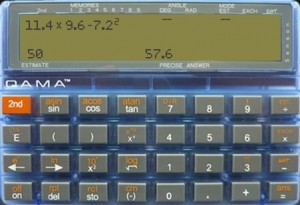Ending the Math Wars in a Treaty of QAMA
As a country, we are often at war. If it’s not against Germany, England, terrorism, or Grenada, it’s the war on poverty (that’s gone so well), the war on cancer (ditto), and, of particular interest to me, the Math Wars, which have been raging for decades. On one side, the traditionalists insist on drilling and back to basics, “on behalf of sanity and quality in math education.” On the other side, the reformers insist on conceptual understanding using computers and calculators, to “promot[e] the rational reform of mathematics education.”
Both are half-right and half-crazy. As the reformers say, students need to understand what the mathematics means. Students whose word problem for “6 x 3 = 18” is of the form “There were 6 ducks, and 3 more showed up, so 6 times 3 is 18,” understand little. (See “Children Learning Multiplication, Part 1,” in the articles by Professor Thomas C. O’Brien.) As the traditionalists say, using computers for everything leads to needing a calculator to compute what 6.5 x 10 is.
However, there’s a tool to combine the merits of both sides: the Quick, Approximate, Mental Arithmetic (QAMA) calculator. (I don’t have any financial interest in the company, or in any calculator or computer company, alas.) Mine just arrived. I typed “25 x 37” and pressed “=”. A short underline cursor flashed away on the bottom left of the screen, without offering an answer. Instead, it demanded an estimate. Like a skilled tutor, it answered my question with its own.
When I entered 100, it asked again. For how could two numbers, each around 30, multiply only to 100? When I tried 400 and even 800, I still got no answer. Only when I tried 900 did the calculator answer my original question and tell me the exact answer (925). By experimenting, I found that, in order to get the exact answer, the estimate must be at least as close as 814–an error of 12 percent.
The calculator is skillfully programmed for learning, for its error tolerance depends on the difficulty of the calculation. When I ask for the tangent of 80 degrees, my estimate can be up to 20 percent in error. At the other extreme, for “6.5 x 10” the estimate needs to be precisely 65. (On the other hand, its strictness is sometimes crazy. The logarithm of 1001 is 3.000434 … However, 3, my first guess, or even 3.0006, which makes an error of 0.006 percent, is not accurate enough!*)
If the QAMA calculator is the only calculator a student uses—and who needs more, for Wernher von Braun designed moon rockets with only a slide rule—she cannot help but think. With each use, rather than becoming dumber to the point of needing a calculator to compute 6.5 x 10, she learns mathematics ever more deeply.
The 30 Years’ War ended in the Peace of Westphalia. Could the 30-years-long Math Wars end in a Treaty of QAMA?
*Update (7/16/12): After an informative discussion with the inventor, I understand why the calculator is so picky here. What I learned was that the calculator mostly allowws a much wider tolerance in logarithm calculations. For example, with log(4000), which is 3.602…, it accepts 3.5. But when the user asks for log(1001), and the calculator demands high accuracy, the user must learn a new idea: the series approximation for the natural logarithm and how to convert the approximation to a base-10 logarithm. Difficult, but educational!


Comments